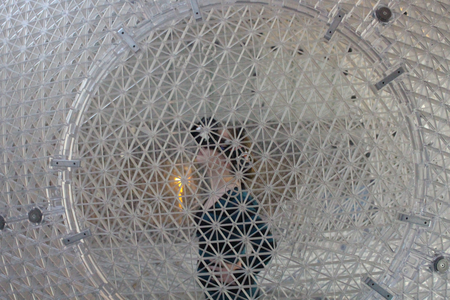Networking of, for and with Alumni: Spatial Cognition
Networking in Space Cognition Artificial
Intelligence Research at the University of Bremen up Close
Cognitive neuroinformatics – a term that drags one into the most exciting research projects with a touch of science fiction. Everything seems possible at the ‘Cartesium’ building on the University of Bremen campus. At least they are ‘thinkable’ and ‘verifiable.’ Prof. Kerstin Schill invited us to experience new projects and challenges to research in the field of artificial intelligence, for example, in the DFG collaborative research center ‘EASE,’ which deals with a household robot working 24/7. It is a system that continuously optimizes itself and ‘learns,’ thanks to adapting its existing skills in order to master highly complex tasks. To program even just the ability of independently fulfilling the task of picking up a glass with different amounts of filling is complicated – not a mundane task, which is therefore supported by different behavioral experiments. At the basis of cognitive neuroinformatics lie assistance systems, orientation systems, and behavioral experiments. The scientists take theories and models to conduct research not only for new automated systems for space missions but specifically also for the use of robotics in, for instance, retirement homes or for the support of automated driving. The alumni were able to look at two research areas in more detail on the fourth floor of the Cartesium.
The group was – thanks to the many participants – split in two and informed alternatingly. That way, both groups learned about the current status of the Enceladus Explorer mission. Enceladus is a moon of Saturn, which is covered in ice. Scientists suspect that there is a global ocean underneath. As is common knowledge, the presence of water is a requirement for the existence of life. The mapping via probes and the evaluation procedures of the submitted data of all sensors is a major challenge keeping scientists busy at the moment. The control system of the probe had been tested on the Langenferner glacier in the Dolomites. By-products of the findings will also be used for self-driving vehicles. The knowledge about position and area along with the algorithms from space travel feed into the work of automotive manufacturing.
The second topic covered empirical research on biological principals of the human brain and their possible transfer on technical systems. The evolution of virtual systems was a fascinating experience. In a large sphere resting on a roller system – the so-called Virtusphere – which you enter with VR goggles, orientation in programmed (real possible and impossible) spaces is reproduced. Without knowing the original coding of the space, a number of sensations is used that humans have intrinsically but robots do not.
Questions of ethics in research, the relationship between economy and science, and the work of never perfect sensors and data that support hypotheses were discussed extensively with the alumni. Everybody was actually quite surprised how busy the halls of the department still were so late at night. The enthusiasm for their work and their possibilities make it difficult for the scientists to find an end to the workday. Curiosity about and passion for the topic are a vital part of it all.
It was an overall fascinating event that stimulated a lot of discussion and sparked excitement for future-oriented topics. The campus with its current research presented itself once more as transparent and inspirational.




















